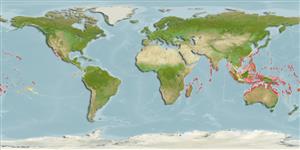>
Ovalentaria/misc (Various families in series Ovalentaria) >
Pomacentridae (Damselfishes) > Microspathodontinae
Etymology: Plectroglyphidodon: Greek,plektron = anything to strike with, spur + Greek, glyphis = carved + Greek, odous = teeth (Ref. 45335).
More on authors: Fowler & Ball.
Environment: milieu / climate zone / depth range / distribution range
Sinh thái học
Biển Cùng sống ở rạn san hô; không di cư; Mức độ sâu 0 - 30 m (Ref. 128797). Tropical; 30°N - 30°S
Indo-Pacific: East Africa to the Hawaiian, Marquesan, and Pitcairn islands, north to the Ryukyu and Bonin islands, south to Lord Howe Island and Rapa. Unknown from the Red Sea, Persian Gulf and Gulf of Oman (Ref. 11441).
Bộ gần gũi / Khối lượng (Trọng lượng) / Age
Maturity: Lm ? range ? - ? cm
Max length : 14.0 cm TL con đực/không giới tính; (Ref. 11441)
Các tia vây lưng cứng (tổng cộng) : 12; Các vây lưng mềm (tổng cộng) : 17 - 19; Tia cứng vây hậu môn: 2; Tia mềm vây hậu môn: 16 - 18.
Adults are found clear water, inner to outer reef crests in rich coral habitat (Ref. 48636). Benthopelagic (Ref. 58302). Common in passages, frequently associated with Acropora, Stylophora, or Pocillopora coral heads or a single head of Pocillopora eydouxi (= Pocillopora grandis). Usually seen solitary (Ref. 48636). Feed on benthic algae and probably coral polyps. Oviparous, distinct pairing during breeding (Ref. 205). Eggs are demersal and adhere to the substrate (Ref. 205). Males guard and aerate the eggs (Ref. 205). Diurnal species (Ref. 13550).
Life cycle and mating behavior
Chín muồi sinh dục | Sự tái sinh sản | Đẻ trứng | Các trứng | Sự sinh sản | Ấu trùng
Oviparous, distinct pairing during breeding (Ref. 205). Eggs are demersal and adhere to the substrate (Ref. 205). Males guard and aerate the eggs (Ref. 205).
Allen, G.R., 1991. Damselfishes of the world. Mergus Publishers, Melle, Germany. 271 p. (Ref. 7247)
IUCN Red List Status (Ref. 130435: Version 2024-2)
Threat to humans
Harmless
Human uses
Các nghề cá: không ích lợi (thú vị); Bể nuôi cá: Tính thương mại
Các công cụ
Special reports
Download XML
Các nguồn internet
Estimates based on models
Preferred temperature (Ref.
123201): 24.7 - 29.2, mean 28.2 °C (based on 2485 cells).
Phylogenetic diversity index (Ref.
82804): PD
50 = 0.5010 [Uniqueness, from 0.5 = low to 2.0 = high].
Bayesian length-weight: a=0.02188 (0.01190 - 0.04023), b=2.95 (2.79 - 3.11), in cm total length, based on LWR estimates for this species & (Sub)family-body (Ref.
93245).
Mức dinh dưỡng (Ref.
69278): 3.4 ±0.6 se; based on diet studies.
Thích nghi nhanh (Ref.
120179): Chiêù cao, thời gian nhân đôi của chủng quần tối thiểu là dưới 15 tháng (Preliminary K or Fecundity.).
Fishing Vulnerability (Ref.
59153): Low vulnerability (10 of 100).
Nutrients (Ref.
124155): Calcium = 91.4 [46.7, 145.6] mg/100g; Iron = 0.68 [0.40, 1.10] mg/100g; Protein = 18.6 [17.4, 19.7] %; Omega3 = 0.114 [0.069, 0.182] g/100g; Selenium = 21.5 [12.4, 40.0] μg/100g; VitaminA = 92.1 [27.5, 293.1] μg/100g; Zinc = 1.43 [0.97, 2.06] mg/100g (wet weight);
